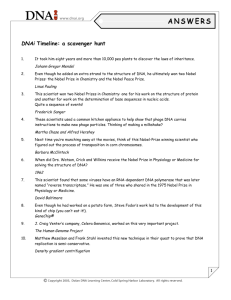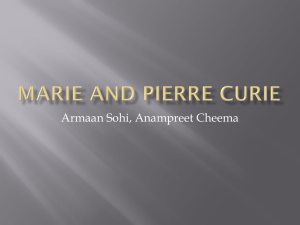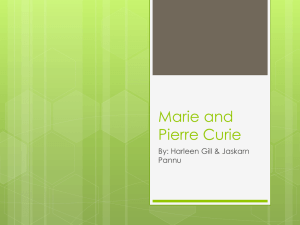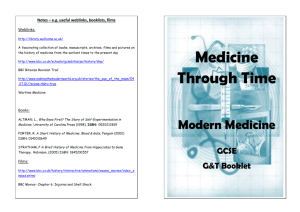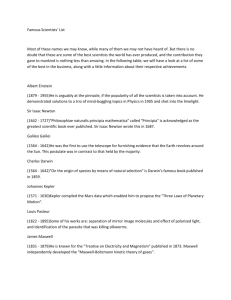Barbara McClintock a Model of Adamant Individually and Self
advertisement
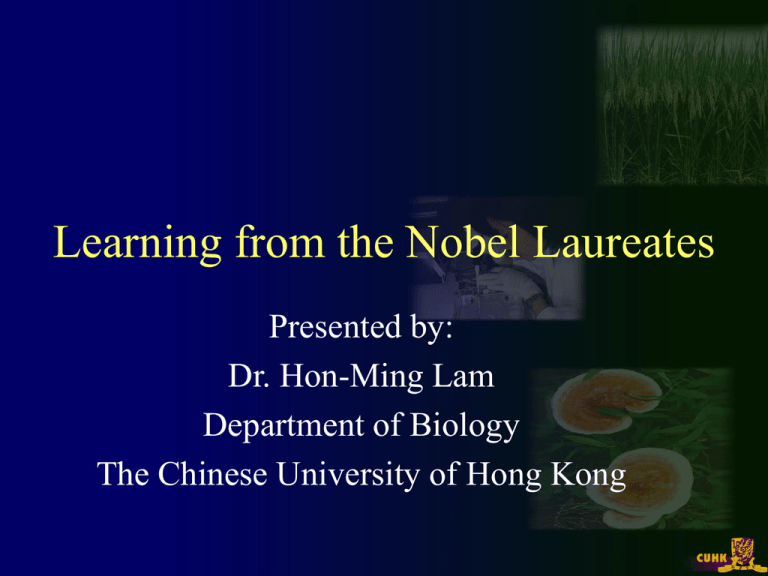
Learning from the Nobel Laureates Presented by: Dr. Hon-Ming Lam Department of Biology The Chinese University of Hong Kong What Constitutes to a Great Scientists? • • • • • • • • Curiosity Sensitivity Determination Dare to Challenge Authority Persistence Creativity Ethics Care for Humanity Alexander Fleming: Sensitivity Catches Luck • In 1928, while working on influenza virus, he observed that a green mold (Penicillium) had developed accidentally on a staphylococcus culture plate and had created a bacteria-free circle around the mold. • The antibiotic penicillin was developed based on this observation. • Penicillin had saved numerous lives especially during WWII. • He received the Nobel Prize on Physiology or Medicine in 1945. Baruj Benacerraf: Determination Drives an Entrepreneur into a Scientist • Coming from a rich family that runs business enterprise • When his father was serious sick, he took charge of the family business • When his father died, he bought a bank in USA and continued his study in Columbia University • In 1957, he quitted the banker job and focused on research • His works contributed to the understanding of genetically determined structures on the cell surface that regulate immunological reactions • He received the Nobel Prize on Physiology or Medicine in 1980 Thomas Cech: Breaking a Scientific Dogma • In the past, most scientists accepted the following dogma: DNA – RNA – Protein – Enzymatic Activities • But the synthesis of DNA and RNA require enzymatic activities – who came first? • Using a protist as a study model, he showed that RNA has catalytic activities • Some pharmaceutical companies are thinking of using this discovery to cure disease due to RNA viruses • He received the Nobel Prize on Chemistry in 1989. Barbara McClintock a Model of Unflagging Persistence • Born in 1902 • National Academy of Sciences USA member in 1944 • Elected president of the Genetics Society of America in 1945 • First report on transposable elements (jumping genes) in 1951 • Nobel Prize on Medicine or Physiology in 1983 1920 1945 1963 1983 James Waston and Francis Crick: Creativity and Innovation Bring Victory • Waston and Crick built the correct DNA model based on data from other scientists (X-ray diffraction by Rosalind Franklin and base-pairing by Erwin Chargaff) • They published their double helix DNA model in 1953 • They received Nobel Prize on Medicine or Physiology in 1962 James Waston: Ethical Controversy • Maurice Wilkins showed James Waston a X-ray photograph on DNA taken by Rosalind Franklin without her prior approval • Many scientists believed that this X-ray was critical for the building of the double helix DNA model; Waston and Crick never acknowledged Franklin in their publication • In the book “Double Helix” by Waston, he described Franklin overbearing, aggressive, emotional, “unfeminine”, and a negative role-model for a proper woman • Franklin died at age 38 in 1958 and could never defend for herself Pierre Curie and Marie Curie: From Science to Humanity • Before getting married, Pierre Curie wrote to Marie “to spend life side by side, in the sway of our dreams: your patriotic dream, our humanitarian dream and our scientific dream • To test if radium could be used in therapy, Pierre tested it on his own skin; radiotherapy was then born; Pierre died in 1906 due to overwork and car accident • During the WWI, Marie used X-rays to help in surgery; the almost blinded Marie died of leukemia in 1934 • Pierre and Marie never patented their findings to improve their own financial situation; they wanted everyone in need to use their inventions Pierre Curie and Marie Curie: From Science to Humanity • Pierre and Marie received Nobel Prize on Physics in 1903, for the discovery of natural radioactive elments (such as polonim and radium) • In 1911, Marie received Nobel Prize on Chemistry, for determining the atomic weight of radium. • Their daughter Irene Joliot-Curie and their son-in-law Frederic Joliot-Curie received Nobel Prize on Chemistry in 1935, for the discovery of artificial radioactive elements Norman Borlaug: Science to Fight Hunger • In 1970, the Nobel Prize Committee awarded the Nobel Peace Prize to Dr. Borlaug for his efforts to increase world food production. The committee called the Green Revolution a “technological breakthrough which makes it possible to abolish hunger in the developing countries in the course of a few years” Norman Borlaug: Science to Stop Hunger

